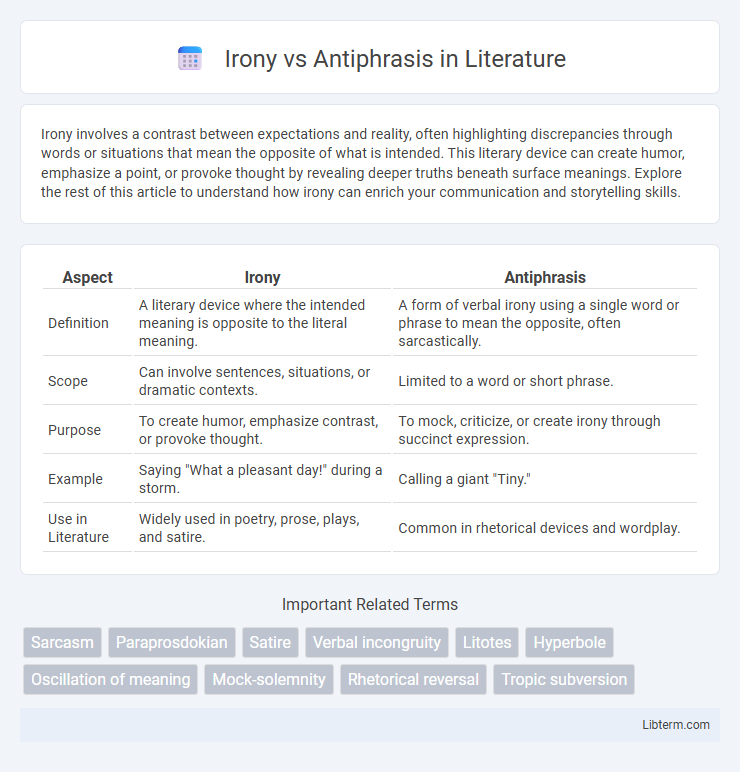Irony involves a contrast between expectations and reality, often highlighting discrepancies through words or situations that mean the opposite of what is intended. This literary device can create humor, emphasize a point, or provoke thought by revealing deeper truths beneath surface meanings. Explore the rest of this article to understand how irony can enrich your communication and storytelling skills.
Table of Comparison
| Aspect | Irony | Antiphrasis |
|---|---|---|
| Definition | A literary device where the intended meaning is opposite to the literal meaning. | A form of verbal irony using a single word or phrase to mean the opposite, often sarcastically. |
| Scope | Can involve sentences, situations, or dramatic contexts. | Limited to a word or short phrase. |
| Purpose | To create humor, emphasize contrast, or provoke thought. | To mock, criticize, or create irony through succinct expression. |
| Example | Saying "What a pleasant day!" during a storm. | Calling a giant "Tiny." |
| Use in Literature | Widely used in poetry, prose, plays, and satire. | Common in rhetorical devices and wordplay. |
Introduction to Irony and Antiphrasis
Irony involves expressing meaning by using language that normally signifies the opposite, often to highlight a contrast between appearance and reality. Antiphrasis is a specific form of irony where a single word or phrase is used in a context that contradicts its usual sense, often for humorous or emphatic effect. Both devices rely on the audience's understanding of the intended opposite meaning to create nuance and rhetorical impact.
Defining Irony: Meaning and Examples
Irony is a rhetorical device where the intended meaning contrasts sharply with the literal expression, often highlighting a discrepancy between appearance and reality. Examples include verbal irony, such as saying "What a pleasant day" during a storm, and situational irony, like a fire station burning down unexpectedly. This linguistic technique enhances communication by adding layers of meaning and provoking thought.
What Is Antiphrasis? Key Characteristics
Antiphrasis is a rhetorical device where a word or phrase is used in a way that is opposite to its literal meaning, often for ironic or humorous effect. Key characteristics include the deliberate contradiction between the intended meaning and the expressed word, the use of context to highlight the opposing sense, and its common appearance in everyday speech and literature to convey sarcasm or emphasize a point. Unlike broader irony, antiphrasis specifically involves using a single word or phrase with inverted meaning.
Historical Origins of Irony and Antiphrasis
Irony traces its roots to ancient Greek literature, particularly the works of Sophocles and Socrates who used it to convey meanings opposite to literal expressions for rhetorical effect. Antiphrasis, a subtype of irony, emerged from classical rhetoric as a figure of speech where a word is used in a sense contrary to its usual meaning, often for humorous or emphatic purposes. Both devices evolved over centuries, influencing literary traditions and everyday language by enhancing expressive and interpretative complexity.
Types of Irony in Language
Verbal irony occurs when a speaker says something but means the opposite, often for humorous or emphatic effect, while antiphrasis is a specific type of verbal irony where a single word or phrase is used to convey the opposite meaning, typically in a sarcastic manner. Dramatic irony arises when the audience knows crucial information that characters do not, creating tension and engagement. Situational irony takes place when there is a stark difference between expected outcomes and actual events, highlighting contradictions in real-life situations or narratives.
How Antiphrasis Functions in Rhetoric
Antiphrasis functions in rhetoric by using words in a sense opposite to their literal meaning to create emphasis or humor, often conveying irony through understatement or exaggeration. This device challenges the audience to recognize the intended meaning behind seemingly contradictory expressions, enhancing persuasion and engagement. Effective antiphrasis relies on context and tone to signal its rhetorical purpose, differentiating it from straightforward irony or sarcasm.
Semantic Differences: Irony vs Antiphrasis
Irony involves expressing meaning by using language that normally signifies the opposite, often for humorous or emphatic effect, whereas antiphrasis specifically uses a word in a sense opposite to its usual meaning, typically as a single word or phrase rather than a full statement. Semantically, irony operates on a broader contextual level, relying on situational or verbal cues to invert meaning, while antiphrasis hinges on lexical inversion within a specific term. Understanding the semantic differences between irony and antiphrasis enhances accurate interpretation of nuanced language in literary and conversational contexts.
Effects on Readers: Humor, Emphasis, and Critique
Irony and antiphrasis both shape readers' perceptions by injecting humor, emphasizing key ideas, and offering critique. Irony often creates a contrast between expectation and reality, provoking thoughtful amusement and highlighting contradictions or flaws in a subject. Antiphrasis delivers meaning through deliberate reversal, enhancing emphasis and sharpening social or rhetorical critique by stating the opposite of what is meant.
Real-World Usage: Literature, Media, and Everyday Speech
Irony often appears in literature and media to highlight contradictions between expectation and reality, such as in Jonathan Swift's "A Modest Proposal." Antiphrasis, a specific form of verbal irony, involves using words in a way opposite to their literal meaning for humorous or emphatic effect, like calling a tall person "Shorty." In everyday speech, irony conveys subtle criticism or humor, while antiphrasis relies on context and tone to signal the speaker's true intent.
Conclusion: Choosing Between Irony and Antiphrasis
Choosing between irony and antiphrasis depends on the intended tone and clarity of the message, as irony often relies on context for understanding, while antiphrasis uses words explicitly to mean the opposite for humorous or emphatic effect. Irony suits complex, subtle communication where the audience can infer underlying meaning, whereas antiphrasis is more direct and impactful in everyday speech or satire. Effective use of either device enhances expression by adding layers of meaning, making the choice a strategic decision based on audience and purpose.
Irony Infographic

 libterm.com
libterm.com